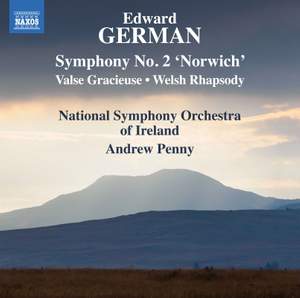
Edward German (1862-1926)
Orchestral Works Volume 2
Symphony No 2 ‘Norwich’ in A minor (1893)
Valse gracieuse (1895, rev. 1915)
Welsh Rhapsody (1904)
National Symphony Orchestra of Ireland/Andrew Penny
rec. 1994, National Concert Hall, Dublin, Ireland
Naxos 8.555228 [57]
In the mid-1990s, Marco Polo set about recording much of Edward German’s orchestral music. This programme was issued in 1995, and is now one of four discs re-released on Naxos.
I have not heard German’s 1st Symphony. His four-movement 2nd Symphony subtitled ‘Norwich’ is apparently even finer. It was commissioned by the Norwich Festival Committee. It has assured orchestration and inventive colours, and its material is often memorable and always clearly presented. There have been other recordings over the last fifty years, but none is now available.
The second movement Andante con moto, the real star for me, is overwhelmingly enchanting. But we start with a sonata-form Allegro preceded by a dark, slow introduction marked Andante maestoso. This powerful movement compares interestingly with the lighter touches of the later Allegro scherzando and the boisterous finale. The last movement at times brought to my mind anything by Dvořák and, possibly less surprisingly, Eric Coates. To me, this is the finest British symphony before Elgar; some of you might even prefer it. David Russell Hulme’s excellent, detailed booklet notes remind us that Elgar thought very highly of Edward German.
German’s most performed orchestral work may be the Welsh Rhapsody, written for the Cardiff Music Festival of 1904. The booklet writer calls it symphonic, and I know what he means. It falls into four distinctly different movements of varying tempi and mood. German uses several traditional melodies. The third part is a whirling Scherzo. The finale begins with a chorale-like idea, and moves into the famous ‘Men of Harlech’ tune developed with much enthusiasm. You might think it’s a little over the top, but it brings the work to a great climax, so it often gets a standing ovation.
The Valse gracieuse was originally part of the Leeds Suite written for the Leeds Festival in 1895. This beautifully scored piece proved so popular that German revised it twenty years later to make an independent concert waltz. If you know German’s famous Tom Jones or his Merrie England with its waltz-songs, then the main melody of Valse gracieuse may remind you how good a tunesmith he could be.
I have known this music for over twenty years, and it never fails to please. The performances and recording are a joy, and do the music proud.
Gary Higginson
Help us financially by purchasing from





















